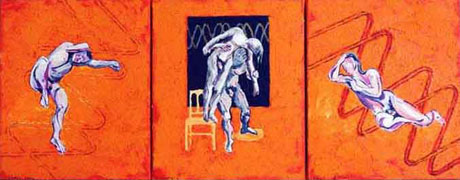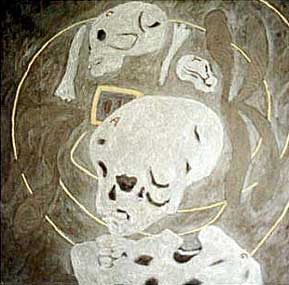Sculpture Studio
Rachael Lashof
Project 4- Self Designed
ARTIST RESEARCH
Source - Self Essays
Eduardo Kac
Jacques Deshaies
Eduardo Kac and Transgenic Art
Eduardo Kac is a transgenic artist from Rio de Janeiro. Kac’s work relates very much to my interest which I have spent the last semester exploring – the interconnected relationship between art and science. His main body of work is interested in the intersections between art, biotechnology, and communication. “Kac merges multiple media and biological processes to create hybrids from the conventional operations of existing communications systems,” (www.ekac.org). Eduardo Kac was one of the first artists who I began exploring this semester.
Transgenic art is Kac’s late 20th century invention
of art that involves organisms whose genes have been mutates, explores issues of biotechnology, among other things (Becker 2000). In one work,
Genesis, Kac translates a biblical excerpt from the book of Genesis
into Morse code and then into genetic code using the four nucleotides:
“Let man have dominion over the fish of the sea, and over the fowl
of the air, and over every living thing that moves upon the earth.”
The resulting gene was created and inserted into bacteria which were displayed
in a gallery. Web viewers could remotely turn on and off an ultraviolet
light, causing mutations in the bacteria, thus changing the code, and
changing the biblical statement. The resulting exhibition asked questions
of what biotechnology is capable of, how we interpret religion and how
belief is changed, issues of ethics, and issues of communication and interaction.
I appreciate Kac’s work Genesis (at right) for the multiplicity
of ideas it lays forth and asks the viewers, whether physically present
or remotely present via the internet, numerous questions which face society
today and most likely even more so in the near future. For my final project,
I hope to achieve some of the duality that Kac achieves in his ‘transgenic’
artworks.
issues of biotechnology, among other things (Becker 2000). In one work,
Genesis, Kac translates a biblical excerpt from the book of Genesis
into Morse code and then into genetic code using the four nucleotides:
“Let man have dominion over the fish of the sea, and over the fowl
of the air, and over every living thing that moves upon the earth.”
The resulting gene was created and inserted into bacteria which were displayed
in a gallery. Web viewers could remotely turn on and off an ultraviolet
light, causing mutations in the bacteria, thus changing the code, and
changing the biblical statement. The resulting exhibition asked questions
of what biotechnology is capable of, how we interpret religion and how
belief is changed, issues of ethics, and issues of communication and interaction.
I appreciate Kac’s work Genesis (at right) for the multiplicity
of ideas it lays forth and asks the viewers, whether physically present
or remotely present via the internet, numerous questions which face society
today and most likely even more so in the near future. For my final project,
I hope to achieve some of the duality that Kac achieves in his ‘transgenic’
artworks.
Kac’s duality of meaning is seen again in his work,
The Eighth Day. Here, Kac uses multiple bioluminescent organisms
 contained
in a small environment. Of the several kinds of organisms contained in
this domed environment, amoebae are enclosed in a ‘biobot,’
– “a robot whose motions are governed by the tiny creatures’
collective activity,” (Eskin 2001). Typically, under stress, these
organisms might act as a whole, behaving as one larger organism. Kac lays
out the duality of this with the idea of a bioluminescent environment
in The Eighth Day (at left).
contained
in a small environment. Of the several kinds of organisms contained in
this domed environment, amoebae are enclosed in a ‘biobot,’
– “a robot whose motions are governed by the tiny creatures’
collective activity,” (Eskin 2001). Typically, under stress, these
organisms might act as a whole, behaving as one larger organism. Kac lays
out the duality of this with the idea of a bioluminescent environment
in The Eighth Day (at left).
Together, Kac’s transgenic artworks continually ask
ethical questions of science and art. The media attention he has garnered
by such works as The GFP Bunny (below), have encouraged discussion
and debate about whether he should even be allowed to do these artworks.
However, they have also brought positive attention to the growing capabilities
of biotechnology and the potential it presents. While Kac realizes there
are many people who view his work, particularly Alba – the GFP bunny,
as art objects, he really sees them as interactive projects which inspire
this continuing debate about the relationships between science, art, communications,
and religion. 
In my final project, I will be exploring Central Dogma – the process of DNA transcription to RNA translated to amino acids. In this exploration, I hope to inspire my viewers to consider the relationships between science, art, and belief. The dictionary definition of dogma is (1) a doctrine or a corpus of doctrines relating to matters such as morality and faith, set forth in an authoritative manner by a church; (2) an authoritative principle, belief, or statement of ideas or opinion, especially one considered to be absolutely true; or (3) a principle or belief or a group of them. Obviously, there is a dual meaning of this term. By exploring the importance of DNA to life and to science, I hope to explore not only the beauty of this complex molecule, but also its role in life, and its role in religious beliefs. The duality of central dogma will be presented in my work as an altar of DNA. This will present the central role of the molecule in life as well as its controversial influence on religious beliefs.
Jacques Deshaies and Transgenic Art

Jacques Deshaies is a French-Canadian artist also inspired by the beauty of biological systems, specifically DNA and the proteins it encodes. Similarly to Eduardo Kac, Deshaies’ work also falls under the category of “transgenic” art, however it is more traditional in form than Kac’s telepresent artworks. While Kac seems to want to make broad comments and encourage questions about the relationships between science, art, religion, and communication, Deshaies seems more inspired by the complex beauty of these life molecules. Thus, Jacque Deshaies’ work takes a more traditional form, primarily painting.

When creating artworks, Deshaies uses scientific renderings of proteins and DNA as well as the idea that these molecules play an important role in some life process. Deshaies is also inspired by the evolutionary history of the role of DNA, and its potential future role in society. He examines the relationship between human being and knowledge of the DNA molecule and its role. This exploration can be seen in many of his works which lay parallels between human being and the molecule of life. “J. Deshaies seeks, as we all must, to transcend everyday reality to reach the true reality of the essence of what our contemporary biotechnology and genetics means for us individually and as societies,” (Sommerville and Langford 1997). Jacques Deshaies explores the ‘DNA culture,’ its past, its ethics, and its future.
 Like
Jacques Deshaies, I am also interested in exploring the “DNA culture.”
Last semester in my genetics class, Professor Rachel Myerowitz remarked
to the class of almost entirely biology majors, that in today’s
aristocratic society, everyone is expected to be well versed in art and
literature and composition. However, the artists and writers may exclaim
they are not scientists, thus they have no need to be knowledgeable of
basic scientific ideas. Oppositely, leading scientists are expected to
be well versed in art and literature. It is artists like Jacques Deshaies
and Eduardo Kac who break this expectation. They encourage their viewers
to look into and challenge the ideas of science as it relates to society.
Like
Jacques Deshaies, I am also interested in exploring the “DNA culture.”
Last semester in my genetics class, Professor Rachel Myerowitz remarked
to the class of almost entirely biology majors, that in today’s
aristocratic society, everyone is expected to be well versed in art and
literature and composition. However, the artists and writers may exclaim
they are not scientists, thus they have no need to be knowledgeable of
basic scientific ideas. Oppositely, leading scientists are expected to
be well versed in art and literature. It is artists like Jacques Deshaies
and Eduardo Kac who break this expectation. They encourage their viewers
to look into and challenge the ideas of science as it relates to society.
Though a lot of Deshaies’s works are literal –
paintings of protein forms, many explore more deeply the “DNA culture.”
 “Jacques Deshaies, through his association of the Meat Plant with
factory walls and smokestacks, also portrays plants as the factories or
bio-reactors of the future,” (Langford 1998). By quoting other artists,
such as Picasso, as he does in this work, Genomic Meat Plant #1 (right),
Deshaies questions the future of the “DNA culture.” How will
society deal with the continuing pressure to develop medical technology
using the resources of biotechnology? Is using our natural resources to
further medical technology and produce drugs exploiting these resources?
How far can we go in developing technologies – to the fountain of
youth? All of these questions are presented in Jacques Deshaies’
“DNA culture” works.
“Jacques Deshaies, through his association of the Meat Plant with
factory walls and smokestacks, also portrays plants as the factories or
bio-reactors of the future,” (Langford 1998). By quoting other artists,
such as Picasso, as he does in this work, Genomic Meat Plant #1 (right),
Deshaies questions the future of the “DNA culture.” How will
society deal with the continuing pressure to develop medical technology
using the resources of biotechnology? Is using our natural resources to
further medical technology and produce drugs exploiting these resources?
How far can we go in developing technologies – to the fountain of
youth? All of these questions are presented in Jacques Deshaies’
“DNA culture” works.
I too, would like to challenge my viewers to achieve a better understanding of the scientific ideas that create life. I would like to explore the “DNA culture.” By paralleling the DNA molecule and the scientific Central Dogma to religious dogma, I hope to question common scientific understanding. I recently heard the statistic that over 60% of Americans do not believe in evolution. Needless to say, I was shocked by this fact. My artwork looks to question what happens when two very different ‘dogmas’ conflict. Like Eduardo Kac, I hope to question how belief changes, (Genesis).
Works Cited
Becker, Carol. “GFP Bunny.” Art Journal. 59.3 (2000): 45-47.
Deshaies, Jacques. “J. Deshaies.” 24 April 2005. < http://www.jacquesdeshaies.com>
Drucker, Johanna. “Eduardo Kac: profile.” Art Journal. 56 (1997): 18-19.
Eskin, Blake. “Building the bioluminescent bunny: with fluorescent proteins and engineered bacteria, Eduardo Kac wields the tools of science in the service of ‘transgenic’ art.” Art News. 100.11 (2001): 118-119.
Kac, Eduardo. “KAC WEB.” 24 April 2005 <http://www.ekac.org/>
Shanken, Edward. "Tele-Agency: Telematics, Telerobotics, and the Art of Meaning." Art Journal. 59.2 (2000): 64-77.
Langford, Jock. “The Meat Plant.” Environment Canada. June 1998.
Reinert, Birgit. “Painting Proteins: Artworks by Jacques Deshaies.” 24 January 2003. Genome Network News. 24 April 2005. < http://www.genomenewsnetwork.org /articles/01_03/jd_art.shtml>
Sommerville, Margaret; and Langford, Jock. “From Evolution to Revolution.” Environment Canada. Feb. 1997.
St. Mary's College of Maryland
St. Mary's City MD 20686-3001
Back to Index
This page was last updated: May 6, 2005 3:10 PM